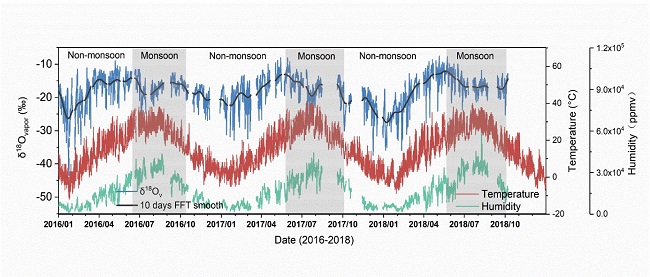Temperature Effect Playing in Regions with Complex Moisture Sources Has Promise
The hydrogen and oxygen isotopes of precipitation are sensitive to environmental changes and record the water cycling information. The variations of stable isotopic composition reflect the physical characteristics of water vapor, such as sources, exchange, and transport processes during its cycling. Therefore, they are widely used as hydrological and climate tracers in paleoclimate reconstruction and water cycling research.
Near-surface water vapor is one of the important components of precipitation. However, there is currently a lack of understanding of the relationship between near-surface water vapor and precipitation, which hinders the use of water vapor hydrogen and oxygen isotopes to conduct related research on precipitation and environmental changes.
By using the water/water vapor isotope analyzer (Picarro L-2130i), the “Extreme Climate Event and Impacts Group” (EXCEIS) from the Institute of Earth Environment of theChinese Academy of Science (CAS) focuses on the questions of the “temperature effect” of precipitation isotope to study and made the following progress.
Through conducting a three-year (2016-2018), high-resolution, relatively continuous water vapor isotopic composition measurements in Xi’an, the duration of the EASM is defined, which normally starts in June and is over in September. The water vapor isotopic results suggested that the establishment of temperature effect of precipitation isotopes should follow two prerequisites: 1. single water vapor source; 2. large temperature gradient.
The results specify the applicable conditions of temperature effect and potentially help us to better use precipitation isotopes to understand the paleo-temperature variations in different regions.

Fig. 1. Hourly variations of water vapor δ18O (blue), temperature (red), and humidity (green) from 2016 to 2018 in Xi’an. (Image by XING, et al)
The work published in the Journal of Hydrology, has been jointly funded by the National Natural Science Foundation of China (42177903) and the Western Light - "Western Young Scholars" (XAB2020YN01) project.
 © 2015 Institute of Earth Environment,CAS
© 2015 Institute of Earth Environment,CAS Address:No. 97 Yanxiang Road, Xi'an 710061, Shaanxi, China

 Location :
Location :